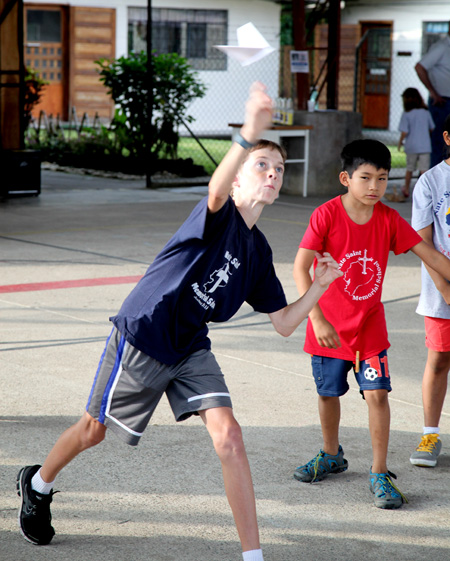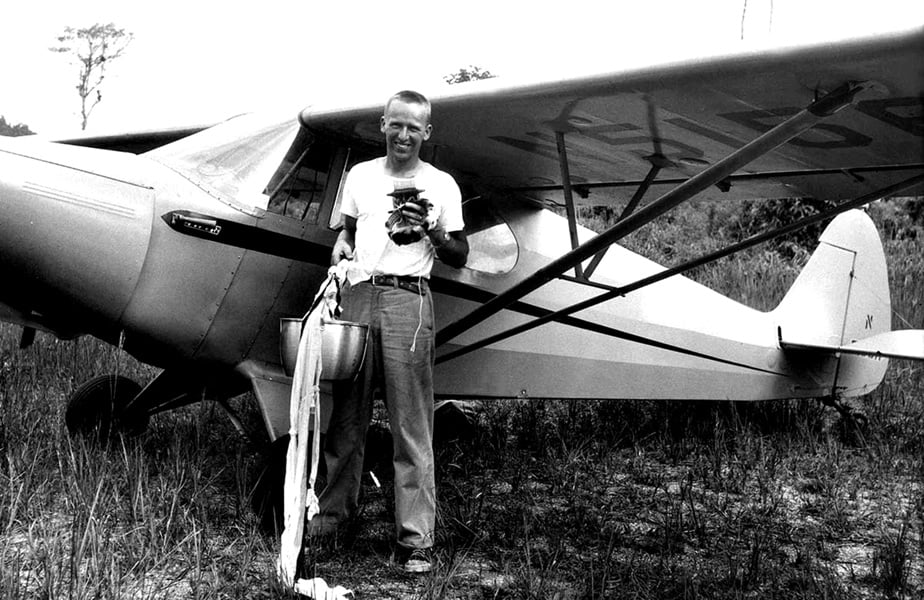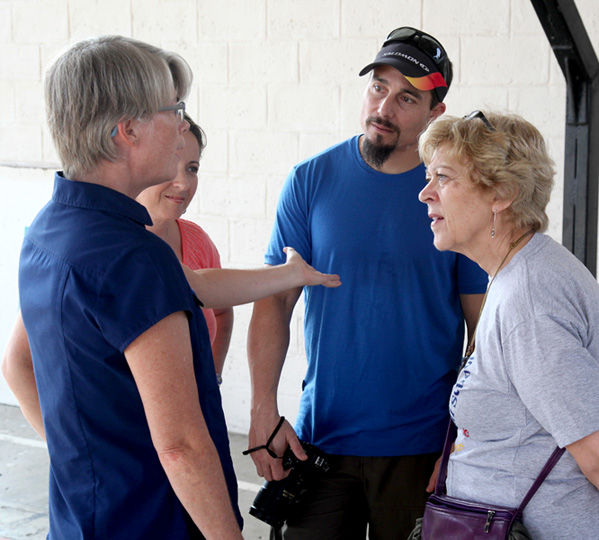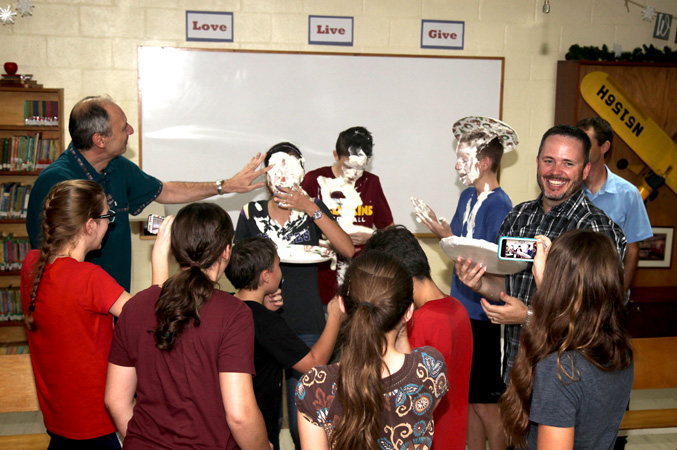MENU
(March 11, 2016 - by Ralph Kurtenbach) Flying paper planes seemed fitting at an event that marked the founding of Nate Saint Memorial School (NSMS) in Shell, Ecuador. Before Saint’s death by spearing with four others in 1956, his work as a missionary pilot took him to remote jungle areas rife with adventure and danger.
 Joshua Fogg, an NSMS seventh-grader, said the paper airplane throwing contest took shape spontaneously during the 50th anniversary celebration earlier this year in Shell. About 100 people attended the get-together.
Joshua Fogg, an NSMS seventh-grader, said the paper airplane throwing contest took shape spontaneously during the 50th anniversary celebration earlier this year in Shell. About 100 people attended the get-together.
With one sheet of paper and five minutes, he explained, “we could make whatever we wanted, however we wanted.” Of more than a dozen youngsters rising to the challenge, all folded their planes in time to compete.
Afterwards, Joshua was offered by an interviewer some possible words to describe his plane design—traditional, avant garde or innovative. “I think [it was] creative,” he replied, “because my friend and I made the plane up. It’s not exactly simple, but it’s a very quick plane to make.”
When it came to going the distance, the 13-year-old’s craft placed fifth in the eyes of judges, Melanie Umble and her husband, Randy, a teacher at the school operated by Reach Beyond.
Of NSMS’s origins, Nate Saint has been quoted as saying the dream sprang from “purely a question of having children at home in their tender years” while their missionary parents served in Shell and the neighboring Amazon rain forest of Ecuador.
As a Philadelphia-area schoolboy, Saint had dangled a pencil on a string during class and dreamed of flying, making ever smaller concentric circles until the pencil settled into a quiet spot in the vortex.
Decades later piloting a plane over the jungle, he could execute a series of pylon turns in the air as a bucket extended on a rope found a place calm enough for those below to reach into it for the contents.
 The recipients were the then-uncontacted Waorani of the Amazon region, known by a pejorative term, “Auca,” which means “savage.” Through gift drops and later outreach, Saint was central to facilitating the first contact to be made between the Waorani and Protestant missionaries.
The recipients were the then-uncontacted Waorani of the Amazon region, known by a pejorative term, “Auca,” which means “savage.” Through gift drops and later outreach, Saint was central to facilitating the first contact to be made between the Waorani and Protestant missionaries.
Preparation for mission work had taken a long trajectory, beginning already during his teenage years in Pennsylvania, marked by dedication to God. It was followed when as a young adult, he trained in aeronautics with mission aviation in mind. His short-lived career was marked by the derring-do and innovation of a pioneering missionary. Not long after the gift drops, Saint’s death came during his own children’s tender years.
A collaborative approach by different mission agencies launched and undertook the 1950s outreach to the Waorani, and in the 1980s Carolyn Wolfram found that good spirit still at play when she taught at NSMS.
 “My time in Shell was wonderful because the community really functioned as an inter-mission community that worked together,” said Wolfram. Arriving in Shell from Ecuador’s capital of Quito for the Jan. 8-10 celebration, she represented at once the NSMS former teachers and former students. Wolfram attended the school and later returned to teach after completing university in North America.
“My time in Shell was wonderful because the community really functioned as an inter-mission community that worked together,” said Wolfram. Arriving in Shell from Ecuador’s capital of Quito for the Jan. 8-10 celebration, she represented at once the NSMS former teachers and former students. Wolfram attended the school and later returned to teach after completing university in North America.
She remembers the mission community in Shell as “not perfect, not without conflicts, but the friendships I have from those years are lifelong.” She still keeps in touch with many friends and former students from her time in Shell. She presently teaches at Alliance Academy International (AAI) in Quito, also established with the children of missionaries in mind.
Saint not only envisioned a school but also a hospital to serve the people of the jungle. Before his death, he had helped in its construction (first known as Epp Memorial, later called Hospital Vozandes del Oriente or HVO).
The healthcare facility was in full swing when Dr. Wally Swanson arrived with his wife, Charlotte. For the 1964-1965 school term, Char held classes in the Swanson home. It was the beginning of what became NSMS.
On Jan. 8, 1966—the 10th anniversary of the slayings of the five missionaries—a new school building was dedicated. It stands on property that Saint and his wife, Marj, had purchased and later donated for mission purposes. Wolfram attended first through fourth grade in the new school before leaving with her family for elsewhere in Ecuador.
 Andi Irwin, parent of an NSMS student and a school board member, later wrote about the 50th anniversary celebration on the blog she maintains with her husband, Chad, a Mission Aviation Fellowship pilot. “There were jars with teachers faces on them,” Andi said, “and you could put your money in the jar of the person you wanted to see get a pie in the face.”
Andi Irwin, parent of an NSMS student and a school board member, later wrote about the 50th anniversary celebration on the blog she maintains with her husband, Chad, a Mission Aviation Fellowship pilot. “There were jars with teachers faces on them,” Andi said, “and you could put your money in the jar of the person you wanted to see get a pie in the face.”
“Miss [Jennifer] Kendrick added in the ninth-graders,” mentioned Joshua Fogg. A photo shows those ninth-graders—Karen Isbell, Josiah Irwin and Jonny Umble—with white cream pie plastered across their faces.
The school’s ownership and administration was handed over to Reach Beyond’s parent organization, World Radio Missionary Fellowship, Inc., in 1967. Since then the school has added such facilities as a resource center, chapel, library and an 11-station computer lab linked to a campus server. After the eighth grade, many of its students have gone on to AAI for high school.
A former teacher, Flo Friesen, had traveled from Manitoba, Canada. She narrated a slide show assembled by a teacher from the school’s earliest days, Liz Kimmer Kirby.
The Shell festivities included an English-language church service and an open-mic event for people to share memories. One attendee, Heather (Waswo) Turner, had taught at NSMS decades ago. For the reunion, she traveled from New Zealand.
Wolfram would have liked more time for conversations with NSMS friends she hadn’t seen in years, but said she enjoyed visiting with those who attended school with her in “the old days.” Looking at photo albums and sharing her own pictures, she had many good conversations that began with, “Do you remember when …?” and ended in laughter.
Photo credits: Mission Aviation Fellowship (all historical images), Chad Irwin
Sources: Reach Beyond, Jungle Pilot
 Joshua Fogg, an NSMS seventh-grader, said the paper airplane throwing contest took shape spontaneously during the 50th anniversary celebration earlier this year in Shell. About 100 people attended the get-together.
Joshua Fogg, an NSMS seventh-grader, said the paper airplane throwing contest took shape spontaneously during the 50th anniversary celebration earlier this year in Shell. About 100 people attended the get-together.With one sheet of paper and five minutes, he explained, “we could make whatever we wanted, however we wanted.” Of more than a dozen youngsters rising to the challenge, all folded their planes in time to compete.
Afterwards, Joshua was offered by an interviewer some possible words to describe his plane design—traditional, avant garde or innovative. “I think [it was] creative,” he replied, “because my friend and I made the plane up. It’s not exactly simple, but it’s a very quick plane to make.”
When it came to going the distance, the 13-year-old’s craft placed fifth in the eyes of judges, Melanie Umble and her husband, Randy, a teacher at the school operated by Reach Beyond.
Of NSMS’s origins, Nate Saint has been quoted as saying the dream sprang from “purely a question of having children at home in their tender years” while their missionary parents served in Shell and the neighboring Amazon rain forest of Ecuador.
As a Philadelphia-area schoolboy, Saint had dangled a pencil on a string during class and dreamed of flying, making ever smaller concentric circles until the pencil settled into a quiet spot in the vortex.
Decades later piloting a plane over the jungle, he could execute a series of pylon turns in the air as a bucket extended on a rope found a place calm enough for those below to reach into it for the contents.
 The recipients were the then-uncontacted Waorani of the Amazon region, known by a pejorative term, “Auca,” which means “savage.” Through gift drops and later outreach, Saint was central to facilitating the first contact to be made between the Waorani and Protestant missionaries.
The recipients were the then-uncontacted Waorani of the Amazon region, known by a pejorative term, “Auca,” which means “savage.” Through gift drops and later outreach, Saint was central to facilitating the first contact to be made between the Waorani and Protestant missionaries.Preparation for mission work had taken a long trajectory, beginning already during his teenage years in Pennsylvania, marked by dedication to God. It was followed when as a young adult, he trained in aeronautics with mission aviation in mind. His short-lived career was marked by the derring-do and innovation of a pioneering missionary. Not long after the gift drops, Saint’s death came during his own children’s tender years.
A collaborative approach by different mission agencies launched and undertook the 1950s outreach to the Waorani, and in the 1980s Carolyn Wolfram found that good spirit still at play when she taught at NSMS.
 “My time in Shell was wonderful because the community really functioned as an inter-mission community that worked together,” said Wolfram. Arriving in Shell from Ecuador’s capital of Quito for the Jan. 8-10 celebration, she represented at once the NSMS former teachers and former students. Wolfram attended the school and later returned to teach after completing university in North America.
“My time in Shell was wonderful because the community really functioned as an inter-mission community that worked together,” said Wolfram. Arriving in Shell from Ecuador’s capital of Quito for the Jan. 8-10 celebration, she represented at once the NSMS former teachers and former students. Wolfram attended the school and later returned to teach after completing university in North America.She remembers the mission community in Shell as “not perfect, not without conflicts, but the friendships I have from those years are lifelong.” She still keeps in touch with many friends and former students from her time in Shell. She presently teaches at Alliance Academy International (AAI) in Quito, also established with the children of missionaries in mind.
Saint not only envisioned a school but also a hospital to serve the people of the jungle. Before his death, he had helped in its construction (first known as Epp Memorial, later called Hospital Vozandes del Oriente or HVO).
The healthcare facility was in full swing when Dr. Wally Swanson arrived with his wife, Charlotte. For the 1964-1965 school term, Char held classes in the Swanson home. It was the beginning of what became NSMS.
On Jan. 8, 1966—the 10th anniversary of the slayings of the five missionaries—a new school building was dedicated. It stands on property that Saint and his wife, Marj, had purchased and later donated for mission purposes. Wolfram attended first through fourth grade in the new school before leaving with her family for elsewhere in Ecuador.
 Andi Irwin, parent of an NSMS student and a school board member, later wrote about the 50th anniversary celebration on the blog she maintains with her husband, Chad, a Mission Aviation Fellowship pilot. “There were jars with teachers faces on them,” Andi said, “and you could put your money in the jar of the person you wanted to see get a pie in the face.”
Andi Irwin, parent of an NSMS student and a school board member, later wrote about the 50th anniversary celebration on the blog she maintains with her husband, Chad, a Mission Aviation Fellowship pilot. “There were jars with teachers faces on them,” Andi said, “and you could put your money in the jar of the person you wanted to see get a pie in the face.”“Miss [Jennifer] Kendrick added in the ninth-graders,” mentioned Joshua Fogg. A photo shows those ninth-graders—Karen Isbell, Josiah Irwin and Jonny Umble—with white cream pie plastered across their faces.
The school’s ownership and administration was handed over to Reach Beyond’s parent organization, World Radio Missionary Fellowship, Inc., in 1967. Since then the school has added such facilities as a resource center, chapel, library and an 11-station computer lab linked to a campus server. After the eighth grade, many of its students have gone on to AAI for high school.
A former teacher, Flo Friesen, had traveled from Manitoba, Canada. She narrated a slide show assembled by a teacher from the school’s earliest days, Liz Kimmer Kirby.
The Shell festivities included an English-language church service and an open-mic event for people to share memories. One attendee, Heather (Waswo) Turner, had taught at NSMS decades ago. For the reunion, she traveled from New Zealand.
Wolfram would have liked more time for conversations with NSMS friends she hadn’t seen in years, but said she enjoyed visiting with those who attended school with her in “the old days.” Looking at photo albums and sharing her own pictures, she had many good conversations that began with, “Do you remember when …?” and ended in laughter.
Photo credits: Mission Aviation Fellowship (all historical images), Chad Irwin
Sources: Reach Beyond, Jungle Pilot
